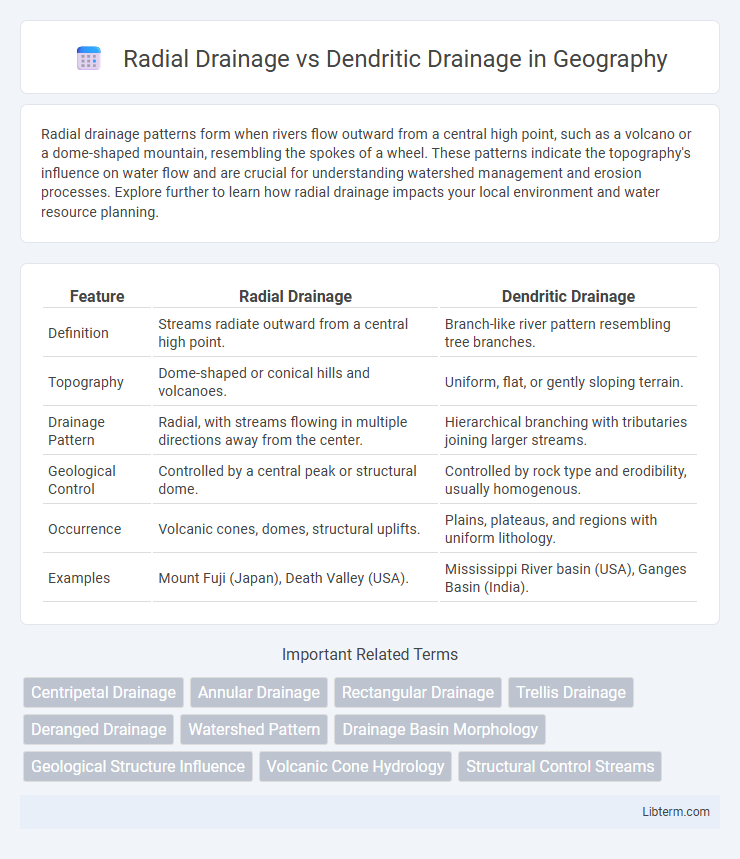Radial drainage patterns form when rivers flow outward from a central high point, such as a volcano or a dome-shaped mountain, resembling the spokes of a wheel. These patterns indicate the topography's influence on water flow and are crucial for understanding watershed management and erosion processes. Explore further to learn how radial drainage impacts your local environment and water resource planning.
Table of Comparison
| Feature | Radial Drainage | Dendritic Drainage |
|---|---|---|
| Definition | Streams radiate outward from a central high point. | Branch-like river pattern resembling tree branches. |
| Topography | Dome-shaped or conical hills and volcanoes. | Uniform, flat, or gently sloping terrain. |
| Drainage Pattern | Radial, with streams flowing in multiple directions away from the center. | Hierarchical branching with tributaries joining larger streams. |
| Geological Control | Controlled by a central peak or structural dome. | Controlled by rock type and erodibility, usually homogenous. |
| Occurrence | Volcanic cones, domes, structural uplifts. | Plains, plateaus, and regions with uniform lithology. |
| Examples | Mount Fuji (Japan), Death Valley (USA). | Mississippi River basin (USA), Ganges Basin (India). |
Introduction to Drainage Patterns
Drainage patterns describe the arrangement of rivers and streams in a region that reflect the underlying geology and topography. Radial drainage develops when rivers flow outward from a central elevated point, such as a volcano or dome, creating a circular pattern. Dendritic drainage resembles tree branches, forming a branching network that develops on homogeneous, flat-lying rock surfaces with uniform resistance to erosion.
What is Radial Drainage?
Radial drainage is a pattern where rivers flow outward from a central elevated point, such as a volcano or dome-shaped hill, resembling the spokes of a wheel. This type of drainage system develops on conical landforms where streams radiate in all directions, efficiently channeling water away from the peak. Radial drainage contrasts with dendritic drainage, which features a tree-like branching pattern following the slope of the terrain.
What is Dendritic Drainage?
Dendritic drainage is a common river pattern resembling the branches of a tree, formed when rivers flow over uniform rock types with gentle slopes. This drainage system develops due to the random branching of tributaries, optimizing the flow of water across the landscape. Radial drainage, in contrast, occurs when streams radiate outward from a central elevated point, like a volcano or dome-shaped hill.
Geological Factors Influencing Drainage Patterns
Radial drainage patterns develop when streams radiate outward from a central high point, often associated with volcanic cones or domes where the geology features a symmetrical uplift. In contrast, dendritic drainage forms in regions with relatively uniform substrate and gentle slopes, where rock type and structural geology allow water to flow in branching, tree-like patterns. Variations in lithology, rock permeability, and tectonic stability critically influence whether a drainage system exhibits radial or dendritic characteristics.
Visual Differences: Radial vs Dendritic Drainage
Radial drainage patterns feature streams radiating outward from a central high point, resembling spokes on a wheel, typically observed around volcanic cones or dome-shaped hills. In contrast, dendritic drainage resembles a branching tree with irregularly shaped tributaries converging downstream, common in regions with uniform substrate and gentle slopes. The visual distinction lies in radial drainage's symmetrical, star-like layout versus dendritic drainage's intricate, vein-like network.
Formation Processes of Radial Drainage
Radial drainage forms when streams flow outward in all directions from a central elevated point, such as a volcanic cone or dome, caused by the uniform slope away from the peak. This pattern develops due to the symmetrical radial slope of the land surface, where erosion channels radiate from the summit. In contrast, dendritic drainage resembles tree branches, forming on relatively flat or gently sloping uniform rock, reflecting a more random and branching drainage pattern driven by substrate homogeneity.
Formation Processes of Dendritic Drainage
Dendritic drainage systems form primarily through uniform erosion of relatively homogeneous rock layers, where water flows follow the path of least resistance, creating irregular branch-like patterns resembling tree limbs. This type of drainage develops on gentle slopes or flat terrain without structural controls like faults or folds, allowing tributaries to join at acute angles. The consistent substrate and lack of geological disruptions promote the dendritic pattern's widespread and dense network formation.
Geographical Examples of Radial Drainage
Radial drainage patterns typically develop around conical highlands such as volcanoes or domes, where rivers flow outward from a central elevated point; notable geographical examples include the streams radiating from Mount Rainier in the USA and the volcanic mountain of Mount Kilimanjaro in Tanzania. Unlike dendritic drainage, which resembles tree branches and forms in regions with uniform substrate, radial drainage indicates a structurally elevated landform influencing river direction. This pattern is prominent in regions with centralized uplift or volcanic activity, reflecting geological processes shaping surface water flow pathways.
Geographical Examples of Dendritic Drainage
Dendritic drainage patterns, characterized by tree-like branching streams, commonly develop in regions with uniform material or gently sloping terrain, such as the Mississippi River basin in the United States and the Amazon Basin in South America. These patterns efficiently drain areas with homogeneous rock types, allowing water to flow in multiple small tributaries converging into larger rivers. In contrast, radial drainage forms around central elevated points like volcanoes or domes, exemplified by the drainage system of Mount Rainier in Washington State.
Comparative Analysis: Radial vs Dendritic Drainage
Radial drainage patterns form when streams radiate outward from a central elevated point, such as a volcanic cone, promoting direct flow paths and efficient water discharge. Dendritic drainage exhibits a tree-like branching pattern influenced by uniform substrate resistance, resulting in tributaries joining larger streams in irregular, meandering ways. In comparative analysis, radial drainage supports rapid runoff from conical landscapes, whereas dendritic drainage maximizes water collection across flat, homogenous terrains, impacting erosion and sediment transport differently.
Radial Drainage Infographic

 libterm.com
libterm.com